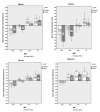Racial variations in the prevalence of refractive errors in the United States: the multi-ethnic study of atherosclerosis
- PMID: 23453694
- PMCID: PMC3759975
- DOI: 10.1016/j.ajo.2013.01.009
Racial variations in the prevalence of refractive errors in the United States: the multi-ethnic study of atherosclerosis
Abstract
Purpose: To describe racial variations in the prevalence of refractive errors among adult white, Chinese, Hispanic, and black subjects in the United States.
Design: Cross-sectional data from a prospective cohort study-the Multi-Ethnic Study of Atherosclerosis (MESA).
Methods: A total of 6000 adults aged 45 to 84 years living in the United States participated in the study. Refractive error was assessed, without cycloplegia, in both eyes of all participants using an autorefractor. After excluding eyes with cataract, cataract surgery, or previous refractive surgery, the eye with the larger absolute spherical equivalent (SE) value for each participant was used to classify refractive error. Any myopia was defined as SE of -1.0 diopters (D) or less; high myopia was defined as SE of -5.0 D or less; any hyperopia was defined as SE of +1.0 D or more; clinically significant hyperopia was defined as SE of +3.0 D or more. Astigmatism was defined as a cylinder value of +1.0 D or more.
Results: After excluding 508 participants with cataracts in both eyes, 838 participants with cataract surgery, 90 participants with laser refractive surgery, and 134 participants who refused to remove their contact lenses for the refraction measurement, 4430 adults with refractive error assessment in at least 1 eye contributed to the analysis. The prevalence of myopia among MESA participants was 25.1%, with lowest rates in Hispanic participants (14.2%), followed by black (21.5%) and white participants (31.0%), and highest rates in Chinese participants (37.2%). The overall rates of high myopia and astigmatism were 4.6% and 45.0%, respectively, with Chinese subjects also having the highest rates of high myopia (11.8%) and astigmatism (53.4%). The overall prevalence of any hyperopia was 38.2% and clinically significant hyperopia was 6.1%, with Hispanic participants having the highest rates of hyperopia (50.2%) and clinically significant hyperopia (8.8%). In multivariate analyses adjusting for age, sex, race, and study site, higher education level, being employed, and being taller were associated with a higher prevalence of myopia. In contrast, lower educational level and being shorter were associated with a higher prevalence of hyperopia.
Conclusions: Myopia and astigmatism were most prevalent in the Chinese population, with Chinese subjects having 3 times the prevalence of myopia as Hispanic subjects. Hyperopia was most common in Hispanic subjects. These findings provide further insights into variations in refractive errors among different racial groups and have important implications for the eye care services in the United States.
Copyright © 2013 Elsevier Inc. All rights reserved.
Figures
References
-
- Lee KE, Klein BE, Klein R, Wong TY. Changes in refraction over 10 years in an adult population: the Beaver Dam Eye Study. Invest Ophthalmol Vis Sci. 2002;43(8):2566–2571. - PubMed
-
- Vitale S, Sperduto RD, Ferris FL., 3rd Increased prevalence of myopia in the United States between 1971-1972 and 1999-2004. Arch Ophthalmol. 2009;127(12):1632–1639. - PubMed
-
- Wang Q, Klein BE, Klein R, Moss SE. Refractive status in the Beaver Dam Eye Study. Invest Ophthalmol Vis Sci. 1994;35(13):4344–4347. - PubMed
-
- Morgan IG, Ohno-Matsui K, Saw SM. Myopia. Lancet. 2012;379(9827):1739–1748. - PubMed
-
- Pan CW, Ramamurthy D, Saw SM. Worldwide prevalence and risk factors for myopia. Ophthalmic Physiol Opt. 2012;32(1):3–16. - PubMed
Publication types
MeSH terms
Grants and funding
LinkOut - more resources
Full Text Sources
Other Literature Sources
Medical
Molecular Biology Databases


